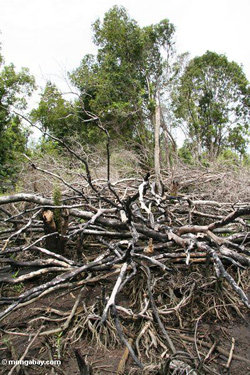Palm oil is a net source of CO2 emissions when produced on peatlands
Palm oil is a net source of CO2 emissions when produced on peatlands
mongabay.com
December 17, 2007
“Solution” to global warming is worse than fossil fuels in terms of emissions. Study finds one ton of palm oil produced on peatland generates 15 to 70 tons of CO2.
|
|
Researchers have confirmed that converting peat forests for oil palm plantations results in a large net release of carbon dioxide, indicating industry claims that palm oil helps fight climate change are unfounded, at least when plantations are established in peatlands.
Performing life cycle analysis of land use change in tropical peatlands, Dr. Susan Page (University of Leicester) and colleagues working on the CARBOPEAT and RESTORPEAT projects found that drained, degraded, and converted peatlands are substantial net sources — not net sinks — of carbon dioxide (CO2). They measured annual CO2 emissions per hectare at 170 metric tons for oil palm plantations and 280 metric tons for acacia pulpwood plantations over the 25-year life cycle. By comparison, natural peat swamp — through tree growth and peat accumulation — acts as a carbon sink, accumulating at least 2.6 metric tons of CO2 per hectare per year. Extrapolating for the 420,000 hectares (ha) of oil palm plantations established on peatlands in Malaysia and 2,800,000 ha for Indonesia, the researchers estimate emissions of 3,220 million metric tons of CO2 over the 25-year lifecycle.
 Logged peat forest in Kalimantan on the island of Borneo. Photo by Rhett Butler. |
The researchers say that producing one ton of palm oil on peatland generates 15 to 70 tons of CO2 over 25 years as a result of forest conversion, peat decomposition and emission from fires associated with land clearance.
“Current land use and land practice developments in Southeast Asia give grave cause for concern. While deforestation rates in non-peatland areas are decreasing slightly owing to depletion of forest resources, those on peatlands have been rising for the last 20 years,” said Page. “In 2005, 25% of all deforestation in Southeast Asia was on peatlands owing to demand for land on which to establish plantations. Current UNFCCC negotiations in Bali on reduced emissions from deforestation and degradation (REDD) could offer a crucial opportunity to reduce carbon emissions from tropical peatlands and thus contribute to combating global climate change.”
Wetlands International, an NGO that has done extensive work on peatlands in southeast Asia, has found that protection and restoration of peatlands are among the most cost-effective options for slowing global warming, with initial investment at around 15 euro cents ($0.22) for every ton of avoided CO2 emissions. By comparison, carbon credits are presently trading at more than 26 euro ($34) per ton on European exchanges.
Page believes that governments should push peatlands conservation as a step towards cutting greenhouse gas emissions.
“The Government of Indonesia should regard its peatlands as a ‘bank’ because they are worth more as biodiversity and carbon stores than oil palm or pulp tree plantations,” she explained. “As a first step it should rescind ALL concession licenses that have been (and still are being) granted for new plantations on its peatland, especially those granted by the decentralized local governments without carrying out Environmental Impact Assessments. It is clear with current rates of peatland conversion that the Indonesian Government cannot reduce its massive non-industrial CO2 emissions unless it stops plantation and other agricultural and industrial uses of its peatlands, and takes serious measures to protect the natural resource functions of biodiversity, carbon and water stores of the remaining peat swamp forests.”
Related articles
10% of global CO2 emissions result from swamp destruction
(12/10/2007) More than 10 percent of annual carbon dioxide emissions result from the degradation and destruction of peat swamps, reports the first comprehensive global assessment on the links between peatland degradation and climate change.
Peatlands restoration is a cheap way to cut CO2 emissions
(12/7/2007) Rehabilitating damaged peatlands in Indonesia may be one of the most cost-effective ways to cut emissions of greenhouse gases, said an international NGO.
Carbon offset returns beat forest conversion for agriculture in Indonesia
(11/21/2007) Conversion of forests and peatlands for agriculture in Indonesia has generated little economic benefit while releasing substantial amounts of greenhouse gases into the atmosphere, reports a new study from the World Agroforestry Centre (ICRAF), the Center for International Forestry Research (CIFOR) and their Indonesian partners.
Oil palm does not store more carbon than forests
(11/8/2007) Officials from the Indonesian ministry of agriculture and the palm oil industry are distributing materials that misrepresent the carbon balance oil palm plantations, according to accounts from people who have seen presentations by members of the Indonesian Palm Oil Commission. Ministry of agricultural officials are apparently arguing that oil palm plantations store and sequester many times the amount of CO2 as natural forests and therefore converting forests for plantations is the best way to fight climate change. In making such claims, these Indonesian officials are ignoring data that show the opposite, putting the credibility of the oil palm industry at risk, and undermining efforts to slow deforestation and reign in greenhouse gas emissions.